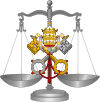Referendary
Referendary is a number of administrative positions, of various rank, in chanceries and other official organizations in Europe.
Pre-modern history
The office of referendarius (plural: referendarii, from the Latin refero, "I inform") existed at the Byzantine Court. Such officials reported to the Emperor on the memorials of petitioners, and conveyed to the judges the Emperor's orders in connection with such memorials.
During the Frankish Empire's Merovingian period, the official who would later be known as the chancellor (cancellarius) was termed the referendarius. See also Royal Administration of Merovingian and Carolingian Dynasties.
Other medieval kingdoms also had a referendary, e.g., Anianus, who in 506 CE compiled the Breviary of Alaric for that king of the Visigoths.
Later the office proliferated and thus became devalued, as reflected in compound titles differentiating some such offices, e.g., in the Polish-Lithuanian Commonwealth. In later iterations of the Polish state, the title occurred again, e.g., as "referendary of state".
A referendary can also be an official (Grand Chancellor) in an order of knighthood, e.g. the Order of Saint Lazarus.
Canon law
 |
| Part of a series on the |
| Canon law of the Catholic Church |
|---|
|
Jus antiquum (c. 33-1140)
Jus novum (c. 1140-1563) Jus novissimum (c. 1563-1918) Jus codicis (1918-present) Other |
|
Sacraments
Sacred places
Sacred times |
|
|
Supreme authority, particular churches, and canonical structures Supreme authority of the Church
Supra-diocesan/eparchal structures
|
|
|
Temporal goods (property) |
|
Canonical documents |
|
Procedural law Pars statica (tribunals & ministers/parties)
Pars dynamica (trial procedure)
Election of the Roman Pontiff |
|
Legal practice and scholarship
Academic degrees Journals and Professional Societies Faculties of canon law
Canonists |
|
|
In the Papal Curia Romana (court), the office of referendarius apostolicus ('apostolic referendary') originated in the Middle Ages; their duty was to receive all petitions directed to the Holy See, to report on them to the pope and to tender him advice. The treatment and decision varied according to the nature of the question: if a favour was concerned, it might be either granted or refused; if some dispute, the pope decided whether it should be referred to a judge. The referendarii were entrusted with all arrangements for these papal decisions, which they had to prepare for the pope's signature (signatura).
From these referendarii developed the court of the Signatura (Collegium referendariorum Signaturæ votantium), concerning which there are various papal constitutions. Pope Innocent VIII (1484–92) introduced a distinction between the referendarii on questions of favours and of justice, whence developed the "Signatura gratiæ" and the "Signatura justitiæ", each competent to give final decision within its sphere. Utriusque Signaturae Apostolicae Referendarius (attested for Joseph Simeon Assemani), or shorter referendarius utriusque signaturae (attested for Francesco Sforza Pallavicino), 'Referendary of both signatures', was a specific title in the Roman Curia, apparently combining both competences.
In the court of the "Signatura justitiæ" developed a distinction between the prelates entitled to vote (prœlati votantes) and those whose duties were confined to reporting on individual cases (prœlati referendarii). The whole body gradually lost all practical importance, especially after the loss of the Papal States, and was entirely abolished at the reorganization of the Curia by Pius X.
Germany
In Germany, Referendar refers to:
- a trainee solicitor/attorney undertaking an articled clerkship as part of his/her professional training, or
- a student teacher during the practical period of teacher training.
Law graduates are employed and paid by the state. He or she works as a law clerk at a court. The training comprises several stages that give the Referendar experience working under supervision in various fields of law. During the first two stages, the Referendar works as a law clerk for a civil court judge and for the local public prosecutor's office.
All law graduates must article as Referendars for two years before being admitted to practice. The traineeship is intended to provide practical knowledge that cannot be taught at university.[1]
For trainee teachers this period lasts between 18 and 24 months depending on the state. During this time, Referendars are employed by and paid for by the state as applicants to the "middle" or "upper service" as government employees (Beamte), depending on which type of school they are training at. A teacher's traineeship consists of academic courses as well as hands-on teaching. At the end of the traineeship, trainee teachers take their Second State Examination to qualify for government employment as teachers.
See Referendar (German article).
Bibliography
- Bruno Katterbach, Referendarii utriusque signaturae a Martino V ad Clementem IX et praelati signaturae supplicationum a Martino V ad Leonem XIII (Vatican City: Bibliotheca apostolica Vaticana, 1931).
- Christoph Weber, Die päpstlichen Referendare 1566-1809: Chronologie und Prosopographie (Stuttgart: Hiersemann, 2004).
- Herbermann, Charles, ed. (1913). . Catholic Encyclopedia. New York: Robert Appleton Company.
- the 1911 Encyclopædia Britannica (passim)
